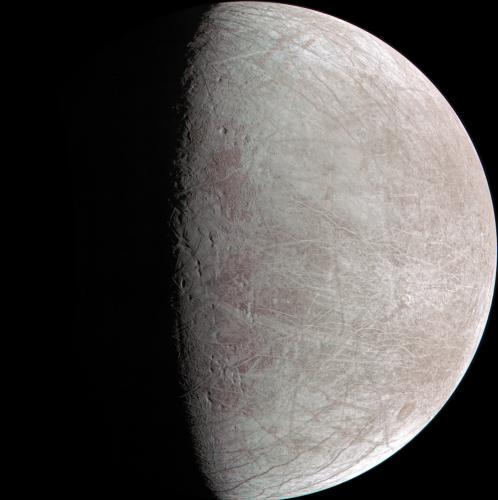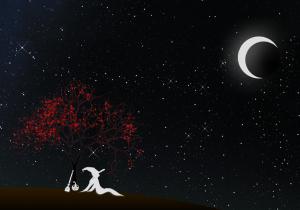Celebration of Space - September 30, 2022
On Thursday, September 29, 2022, the NASA Juno Mission, which has been in orbit around Jupiter for the past six years, made a super close flyby of Jupiter’s icy moon, Europa. This is the first close flyby of Europa since the NASA Galileo spacecraft zoomed by in early 2000. During the current pass, Juno came within 318 miles of Europa. To put that into context, the International Space Station orbits Earth at an altitude of about 200 miles. When the pass occurred, Juno was moving at 14.7 miles per second, but was still able to capture several high-resolution images, and fantastic datasets on Europa’s ionosphere, composition, and interior. Check out one of the images captured by Juno that was processed by the Frosty Drew Astronomy Team. Then check out the Europa Clipper Mission (https://europa.nasa.gov/) which is slated to launch in 2024, with the goal of studying Europa close up.
Sadly, due to weather forecasts for rain and wind, we had to cancel our annual International Observe the Moon Night event (InOMN). This isn’t the first time we have to cancel the InOMN event, and it will probably not be the last. Even though we are canceled, the event is still happening at thousands of locations around the world. Fret not, all the activities and views we had planned for InOMN will be rescheduled into our regular Stargazing Nights events on the following Friday nights, including NASA Solar System Ambassador, Frank Puglia’s presentation, our Apollo 11 Landing Site Panoramic exhibit in the Science Center, and of course – fabulous views of the Moon in the Frosty Drew telescopes. So kick back on Saturday night, stay out of the rain and wind, and watch some of the live streams that will be broadcast on InOMN from the comfort of home.
Evening passes of the International Space Station (ISS) have been happening over our region, and will continue this weekend and through next week, with a few excellent passes lined up. To see the ISS pass overhead, you do not need any specialized equipment, only a view of the sky and relatively clear conditions. Being that the ISS orbits Earth inclined 51º to Earth’s equator, the ISS is not always visible when it passes. To see the station, the observer needs to be at a location where the Sun is below the horizon, but where the station is still in direct sunlight. The ISS is too distant to see any light emitting from the station, and all an observer sees is reflected sunlight. Here are a few notable passes for this weekend and coming week:
Fri, Sep 30 at 7:58 pm, starting in the NW, rising to 41º, and into orbital sunset
Sat, Oct 1 at 7:09 pm, starting in the NW, rising to 28º, heading towards the E, and into orbital sunset.
Sat, Oct 1 at 8:46 pm, starting in the WNW, rising to 25º and into orbital sunset
Sun, Oct 2 at 7:57 pm, starting in the WNW, rising to 80º, heading towards the SE, and into orbital sunset ← Awesome pass!
Mon, Oct 3 at 7:08 pm, starting in the NW, rising to 60º heading towards the ESE, and into orbital sunset. ← Awesome pass!
Tue, Oct 4 at 7:56 pm, starting in the WNW, rising to 28º, heading towards the S, and into orbital sunset.
Wed, Oct 5 at 7:07 pm, starting in the WNW, rising to 49º, heading towards the SE
Note that these pass times are applicable to Southern New England, and are generally acceptable for the entire Northeast. For daily pass times of the ISS and other bright satellites, visit the Frosty Drew Daily Satellite Pass Prediction Utility. Get out and see some station!
Save the Date:
Spooky Views – A Halloween Stargazing Experience
Join us on Friday, October 28, 2022 from 6:00 pm – 10:00 pm, for our annual Spooky Views stargazing event. The Frosty Drew Observatory and Science Center will be in full out Halloween mode with freaky sights and sounds. We will host family friendly story times Under the Willow, scavenger hunts for the kids, a creepy walk to spaceport, RI, and more. Twice during the event we will present the original War of the Worlds radio broadcast by Orson Wells in the Sky Theatre accompanied by select images shown on screen. In the Observatory we will observe the planets, and a graveyard of stars that have recently died and cast off their outer layers as a ghostly glowing ring around the dead star. Candy, and certainly a few scares will be available for all who show up. Costumes are encouraged, but certainly not required.
- Author:
- Scott MacNeill
- Entry Date:
- Sep 30, 2022
- Published Under:
- Scott MacNeill's Columns





